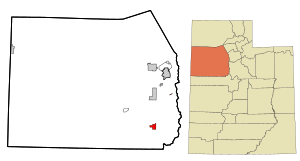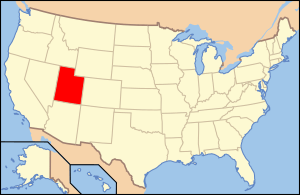Vernon, Utah facts for kids
Quick facts for kids
Vernon, Utah
|
|
|---|---|

Vernon Elementary School, January 2009
|
|
| Etymology: Joseph Vernon | |

Location of Vernon within Tooele County and Utah
|
|

Location of Utah within the United States
|
|
| Country | United States |
| State | Utah |
| County | Tooele |
| Settled | 1857 |
| Incorporated (Onaqui) | 1934 |
| Incorporated (Vernon) | February 22, 1972 |
| Named for | Joseph Vernon |
| Area | |
| • Total | 8.06 sq mi (20.88 km2) |
| • Land | 8.06 sq mi (20.88 km2) |
| • Water | 0.00 sq mi (0.00 km2) |
| Elevation | 5,512 ft (1,680 m) |
| Population
(2010)
|
|
| • Total | 243 |
| • Estimate
(2019)
|
356 |
| • Density | 44.16/sq mi (17.05/km2) |
| Time zone | UTC-7 (Mountain (MST)) |
| • Summer (DST) | UTC-6 (MDT) |
| ZIP code |
84080
|
| Area code(s) | 435 |
| FIPS code | 49-80200 |
| GNIS feature ID | 2413430 |
Vernon is a small town located in southeastern Tooele County, Utah, United States. It is known for being the birthplace of World War II hero Mervyn Sharp Bennion.
Contents
About Vernon, Utah
Vernon is found along Utah State Route 36 in the southern part of Rush Valley. It is also considered part of the larger Salt Lake City area. In the year 2000, about 236 people lived in Vernon.
Where is Vernon Located?
The town covers an area of about 7.5 square miles (20.88 square kilometers). All of this land is dry land, meaning there are no large lakes or rivers within the town's borders.
What is Vernon's Climate Like?
Vernon has a special type of climate called a hot-summer mediterranean continental climate. This means it has hot, dry summers and winters that are usually mild to cool.
The hottest temperature ever recorded in Vernon was 106°F (41°C). This happened on July 13, 2002, and again on June 24, 2007. The coldest temperature recorded was a chilly -26°F (-32°C) on December 23, 1990.
| Climate data for Vernon, Utah, 1991–2020 normals, extremes 1953–present | |||||||||||||
|---|---|---|---|---|---|---|---|---|---|---|---|---|---|
| Month | Jan | Feb | Mar | Apr | May | Jun | Jul | Aug | Sep | Oct | Nov | Dec | Year |
| Record high °F (°C) | 63 (17) |
67 (19) |
81 (27) |
86 (30) |
96 (36) |
106 (41) |
106 (41) |
102 (39) |
99 (37) |
90 (32) |
77 (25) |
76 (24) |
106 (41) |
| Mean maximum °F (°C) | 53.7 (12.1) |
57.7 (14.3) |
69.2 (20.7) |
76.7 (24.8) |
85.4 (29.7) |
94.5 (34.7) |
99.1 (37.3) |
97.1 (36.2) |
91.4 (33.0) |
81.3 (27.4) |
67.3 (19.6) |
56.1 (13.4) |
99.8 (37.7) |
| Mean daily maximum °F (°C) | 39.4 (4.1) |
43.9 (6.6) |
52.1 (11.2) |
58.4 (14.7) |
69.4 (20.8) |
81.0 (27.2) |
90.1 (32.3) |
88.2 (31.2) |
78.6 (25.9) |
64.4 (18.0) |
50.4 (10.2) |
39.2 (4.0) |
62.9 (17.2) |
| Daily mean °F (°C) | 25.7 (−3.5) |
30.1 (−1.1) |
37.9 (3.3) |
43.5 (6.4) |
52.9 (11.6) |
63.0 (17.2) |
71.5 (21.9) |
69.7 (20.9) |
60.3 (15.7) |
47.4 (8.6) |
35.2 (1.8) |
25.7 (−3.5) |
46.9 (8.3) |
| Mean daily minimum °F (°C) | 12.0 (−11.1) |
16.3 (−8.7) |
23.7 (−4.6) |
28.7 (−1.8) |
36.3 (2.4) |
44.9 (7.2) |
52.8 (11.6) |
51.2 (10.7) |
42.0 (5.6) |
30.3 (−0.9) |
20.0 (−6.7) |
12.2 (−11.0) |
30.9 (−0.6) |
| Mean minimum °F (°C) | −4.5 (−20.3) |
−1.0 (−18.3) |
9.7 (−12.4) |
17.0 (−8.3) |
24.9 (−3.9) |
32.9 (0.5) |
43.0 (6.1) |
41.6 (5.3) |
29.7 (−1.3) |
17.8 (−7.9) |
2.9 (−16.2) |
−3.8 (−19.9) |
−9.5 (−23.1) |
| Record low °F (°C) | −22 (−30) |
−25 (−32) |
−10 (−23) |
3 (−16) |
16 (−9) |
22 (−6) |
35 (2) |
24 (−4) |
16 (−9) |
−4 (−20) |
−16 (−27) |
−26 (−32) |
−26 (−32) |
| Average precipitation inches (mm) | 0.77 (20) |
0.90 (23) |
1.00 (25) |
1.09 (28) |
1.29 (33) |
0.71 (18) |
0.70 (18) |
0.71 (18) |
0.83 (21) |
1.07 (27) |
0.76 (19) |
0.77 (20) |
10.60 (269) |
| Average snowfall inches (cm) | 8.4 (21) |
9.5 (24) |
3.9 (9.9) |
2.3 (5.8) |
0.0 (0.0) |
0.0 (0.0) |
0.0 (0.0) |
0.0 (0.0) |
0.0 (0.0) |
0.9 (2.3) |
4.8 (12) |
6.6 (17) |
36.4 (92) |
| Average precipitation days (≥ 0.01 in) | 5.6 | 5.7 | 6.3 | 7.1 | 7.7 | 3.8 | 4.1 | 4.7 | 4.2 | 4.7 | 4.9 | 4.8 | 63.6 |
| Average snowy days (≥ 0.1 in) | 3.9 | 3.5 | 2.5 | 1.1 | 0.0 | 0.0 | 0.0 | 0.0 | 0.0 | 0.5 | 2.4 | 3.6 | 17.5 |
| Source 1: NOAA | |||||||||||||
| Source 2: National Weather Service | |||||||||||||
History of Vernon
The area where Vernon is located was first settled in 1857. The town gets its name from Joseph Vernon, one of the early pioneers who settled there.
How Vernon Became a Separate Town
In 1934, a much larger town called Onaqui was created. It included Vernon, along with other settlements like Clover and St. John. However, Vernon was quite far from the other parts of Onaqui. People in Vernon always felt like their community was separate.
On February 22, 1972, the residents of Vernon asked to become their own town. Their request was approved. The remaining part of Onaqui was then renamed Rush Valley.
Population of Vernon
| Historical population | |||
|---|---|---|---|
| Census | Pop. | %± | |
| 1870 | 111 | — | |
| 1880 | 181 | 63.1% | |
| 1890 | 249 | 37.6% | |
| 1900 | 196 | −21.3% | |
| 1910 | 365 | 86.2% | |
| 1920 | 275 | −24.7% | |
| 1930 | 341 | 24.0% | |
| 1980 | 181 | — | |
| 1990 | 181 | 0.0% | |
| 2000 | 236 | 30.4% | |
| 2010 | 243 | 3.0% | |
| 2019 (est.) | 356 | 46.5% | |
| U.S. Decennial Census | |||
According to the census from 2000, there were 236 people living in Vernon. These people lived in 77 households, and 59 of these were families. The town had about 31.4 people per square mile.
Most of the people living in Vernon were White (94.07%). A small number were from other racial groups. About 4.66% of the population identified as Hispanic or Latino.
Households and Families
Out of the 77 households, about 42.9% had children under 18 living with them. Most households (68.8%) were married couples living together. About 7.8% of households were led by a female without a husband present.
The average household had about 3.06 people. For families, the average size was 3.62 people.
Age Groups in Vernon
The population of Vernon was spread across different age groups:
- 34.7% were under 18 years old.
- 10.2% were between 18 and 24 years old.
- 22.5% were between 25 and 44 years old.
- 21.6% were between 45 and 64 years old.
- 11.0% were 65 years or older.
The average age in Vernon was 30 years. For every 100 females, there were about 91.9 males.
Income in Vernon
In 2000, the average income for a household in Vernon was $42,500 per year. For families, the average income was $43,500. Men generally earned more than women. The average income per person in the town was $13,053.
About 10.7% of families and 13.2% of the total population lived below the poverty line. This included 21.5% of children under 18 and 3.8% of people aged 65 or older.
See also
 In Spanish: Vernon (Utah) para niños
In Spanish: Vernon (Utah) para niños

